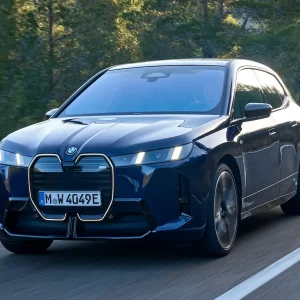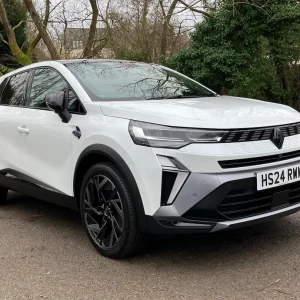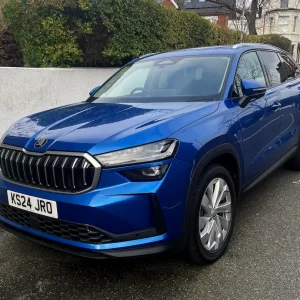A firm fleet favourite, Vauxhall’s Astra has been a UK bestseller for the past 42 years, with over three million sold over seven-generations. Now there’s an all-new eighth-generation model, which also debuts a plug-in hybrid model for the first time.
You won’t miss the Astra thanks to its exterior styling. It follows Vauxhall’s new bold and pure design theme that first debuted on the Mokka SUV in 2021. At the front, there’s the same distinctive ‘vizor’ where the headlights are seamlessly integrated into the darkened grille panel. The headlights are clever too, with the latest evolution of their Intelli-Lux headlights, with 168 LED elements.
Elsewhere, the latest model has muscular wheel arches, plus a design cue that’s a nod to the original Mk 1 Astra – the C-pillar detail around the rear door. The two-tone roof on GS Line and Ultimate also cleverly makes this hatch look lower.
The rear of the new Astra is in Vauxhall’s ‘compass’ style, with the long LED lights stretching across the rear and an unusual vertically designed third rear brake light mounted in the spoiler, plus the Vauxhall badge, which is also the boot catch in the centre.
This latest Astra is both attractive and distinctive, in fact we’d go as far as to say it must be one of the best-looking cars in the C-segment.
The inside of the Astra is equally distinctive, with its minimalist look – although thankfully Vauxhall’s designers have kept physical buttons for everyday items, such as the heating and ventilation. The dashboard is dominated by the two large displays called Pure Panel. These screens, which are 10in in size, show car and infotainment information. Although, we understand that production mid and upper spec Astras will get a sleeker looking version of Pure Panel with a continuous surface. Elsewhere, there’s a stylised multifunction steering wheel.
The Astra’s infotainment is easy to use, with the head-up display where fitted, easy to read with plenty of information. Vauxhall is claiming best-in-class front seats, which are comfortable and supportive and the driving position is also multi-adjustable. There’s also plenty of soft plastic trim around the cabin, but there are too many different grains and the overall effect isn’t as attractive as key rivals.
Space in the front is fine, but rear space is no better than average, although the 422-litre (352 litres on PHEV models) boot is practically shaped.
A fully electric version of this Astra is due next year, but for the first time and available from launch, are plug-in Hybrid-e versions. This is because the Astra is now based on the latest Stellantis EMP2 V3 platform that also underpins, among others, the incoming all-new Peugeot 308.
The Hybrid-e in the range-topping Ultimate equipment grade was the car we spent most time in at the international launch. It combines a 150hp, 1.6-litre petrol turbo engine with a 12.4kWh lithium-ion battery, with the result being 180hp, 360Nm of torque, 0-60mph acceleration in 7.6 seconds and a top speed of 140mph. Of more interest to business buyers is the confirmed 7% BIK figure, 24-27g/km CO2 emission figures, the combined fuel consumption up to 256mpg, and the fact it can be driven 43 miles on electric power alone.
The Astra hybrid starts off smoothly, keenly and quietly in Electric mode, although there are also Hybrid and Sport modes. It will stay in Electric mode until the battery runs out, then will swap into Hybrid mode.
To make the most of the battery range we quickly changed to Hybrid mode, which largely feels like the Electric mode, apart from the altered weighting of the throttle and steering. Jab the accelerator for overtaking and out-of-town driving, and the petrol engine slickly and smoothly takes over the power. Then, when the roads opened out, we tried out the Sport mode, which again gives more weight to the steering and throttle. Performance is best described as brisk.
The first thing to impress on the drive is the refinement and general damping. The interior in general stays whisper quiet – even when the engine is under load and at motorway speeds. The ride, even on the modest standard 18in alloy wheels, was well-judged and was only affected at low speeds.
The Astra has accurate and composed handling, but this is no Focus, as the steering could do with more feel. The only other thing spoiling the Astra PHEV are the brakes, which are sometime hard to modulate.
Also available in 110hp and 130hp petrol and 130hp diesel versions, we also took the opportunity to drive the familiar 1.2-litre three-cylinder petrol with 130hp, and a six-speed manual gearbox. The drive experience is largely the same as for the hybrid, the petrol seemly torquey from low down and well-matched to the slick, six-speed manual transmission.
With the plug-in hybrid version, simplified range of Design, GS Line and Ultimate trims, plus an also attractive Sport Tourer estate available later this year, there should be an Astra for everyone. What they will get is an attractive and capable car, at a generally affordable price.
Vauxhall Astra 1.6 PHEV Ultimate
P11D: £35,260
Residual value: 31%
Depreciation: £24,327
Fuel: £1,556
Service, maintenance and repair: £1,908
Cost per mile: 46.31p
Fuel consumption: 256.8mpg
CO2 (BIK %): 27g/km (7%)
BIK 20/40% a month: £41/£82
Luggage capacity: 352 litres
Engine size/power: 1,598cc/180hp





